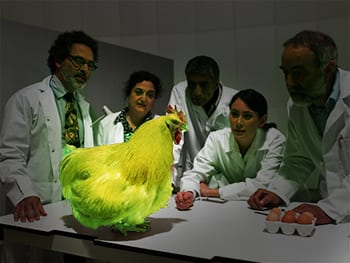

In order to fight deadly diseases, we first must understand them. That's where BSL3 labs come in. Their job is to learn everything they can about the hollow-point bullets Mother Nature likes to shoot at us. For example, remember the Black Death? The disease that once reduced the world population by at least 20 percent? BSL3 scientists are actually working with those very bacteria because, unpleasant surprise, the disease is still around and kicking (people to death.) Last year, 11 Americans were infected with the plague, three of whom actually died. Rose notes that "the plague is actually easily treatable with antibiotics," which is why she and her colleagues had to "go on antibiotics whenever [we're] working with live plague bacteria." Her current lab even keeps "an unofficial stash of the drug Truvada [an HIV-prevention medication] in case of accidents with HIV. "

Let's just say the candy dish they have in the break room doesn't have a lot of room for Jolly Ranchers.
This kind of lab is a curious blend of modern technology and medieval times. In addition to the plague, Rose and her colleagues have to worry about drug-resistant tuberculosis -- good ol' Doc Holliday-style consumption, only now wearing a medicine-proof Kevlar vest -- which has a mortality rate of over 31 percent.
"Some of my colleagues who work on HIV think we'll roll back the tide in the next 10 years while TB is going to continue to be a huge problem," she says. "Totally drug-resistant TB is such a scary idea they don't even want you to say its name, like it's Voldemort or something."
Well, thanks for telling us after we already said it.

So at what point, exactly, do you get to survey your horrid creation and cackle maniacally, as is the ultimate goal of all scientists? Rose enlightens us: "We had a really neat piece of equipment called an 'in vivo imager' which was essentially an ultra-sensitive camera," Rose explains. "You could tag viruses or bacteria with genes that made glowing proteins, inject them into animals, and pop the animals in the imager to see where in their bodies the germs went. We had a glowing plague strain and a glowing monkeypox. You could watch the natural course of the disease and you would see it tear through the animals."
Rose was trying to take some poxviruses (viruses that cause giant pimples) and metaphorically hit them in the knees with her science crowbar until they became docile enough to become vaccine carriers. She wasn't sure the rehabilitated vaccine-viruses would work, though, so: "My supervisor suggested we use the in vivo imager to at least see if the poxvirus would work in chickens," she continues. "We used a 'marker' strain of the poxvirus that had a luminescent gene and then used the imager to capture tiny amounts of light from the luminescent viruses through the flesh of a live animal ... As far as I know, I'm the first person in the world to take pictures of a glow-in-the-dark chicken."

Hopefully this all works and leaks to the mass market, so we can all enjoy a nice KFC Bucket Lantern.
Original article and pictures take http://www.cracked.com/personal-experiences-2062-the-horrifying-realities-working-with-deadly-diseases.html site
Комментариев нет:
Отправить комментарий